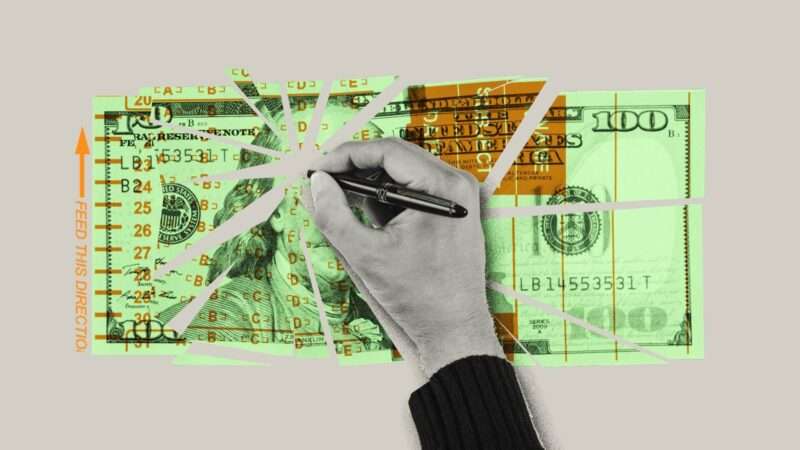
One of the perennial defenses of mediocre public K-12 schools is that they just don't have enough money to work with. Liberal groups like The Center for American Progress routinely put out videos like this one denouncing the "underfunding of K-12 schools" that call for more and more money to be spent.
I don't know about you, but when I hear the phrase the underfunding of schools, my head explodes. Not because I dislike kids or public schools; my two sons exclusively attended public schools. What gets my goat is the demonstrably false idea that schools are being starved for resources. Tax revenue per student in public K-12 schools is up 24 percent nationally over the past two decades, and that takes inflation into account.
In New York, where I live, real per-pupil revenue has increased by a mind-boggling 68 percent between 2002 and 2019. Public schools in the Empire State are now shelling out more than $30,000 per kid. That's more than double the national average, and it doesn't even include the $16 billion extra that New York's system got in combined federal and state COVID-19 relief funding.
Yet New York's public schools are still as terrible as the Mets, the Jets, and the Giants, with only a third or fewer of students up to grade level in eighth grade reading and math, according to their scores on the National Assessment of Educational Progress (NAEP), widely considered the gold standard for judging school outcomes. Those scores aren't much different than they were 20 years ago.
In fact, $30,000 a year puts the lie to the argument pushed by unions and progressives that more money will fix schools. More money hasn't helped the rest of the country boost their scores either. According to NAEP, whatever minor improvements in reading and math that were made for students ages 9 and 13 since the early 1970s have flattened since the early 2000s. We're paying more for the same results.
None of this is a mystery. The connection between bigger spending and good outcomes is weak at best, whether we're talking about comparisons among U.S. states or international ones.
Certainly the new money for New York hasn't gone to fundamentally reform what gets taught, or how, or under what circumstances. According to a report on spending trends in the 21st century by my colleagues at the Reason Foundation (which publishes this website), overall teacher compensation is way up in New York, especially when it comes to benefits like health insurance and pensions, which have grown by 147 percent. Nationwide, a dozen states increased spending on benefits for teachers by over 100 percent and only three states kept the increase below 10 percent. Costs for things like administration, support staff, and transportation are up another 24 percent. Just to reiterate: All these figures are adjusted for inflation.
Dumping more money into a broken system is like trying to fix a leaky pipe by pouring more water into it. What needs to happen is a revolution in how education is conceived and delivered. Over the past 20 years, New York has allowed publicly funded charter schools to operate, which is a good thing because it allows for experimentation while insisting on accountability. Unlike conventional public schools that get students (and funding) assigned to them based on their addresses, charters must attract and keep students in order to stay in business. They start with zero dollars to spend. The best charters have massive wait lists even though they get less money per student than traditional public schools. Charters in New York City, for instance, get about 20 percent fewer dollars per kid than typical public schools.
But instead of expanding the number of charters, New York, like most states, caps it. According to the state's official data, there are just 359 charters compared to 4,411 public schools. Worse, New York doesn't allow education savings accounts (ESAs), tax-credit scholarships, and vouchers that would allow more families to escape traditional public schools and pick where their kids go to learn.
Increasing the amount and variety of school choice, though, is exactly what New York and the country need to be doing (kudos to the 18 states that have started or expanded choice programs). We're not going to seriously improve educational outcomes for our kids if we don't fundamentally change how we educate them.
When you look back 20 years, virtually every other service in our lives—from coffee drinks to media to medicine—has gone through multiple revolutions in terms of what's available and the quality of what's being offered. Everything becomes more geared toward the individual, more responsive, and usually not just cheaper in real terms, but better too. This is obviously true when it comes to things like food and consumer electronics but it's also true of big-ticket items like cars, which cost the same as they did 20 years ago in inflation-adjusted dollars (but are massively superior today). Overall, medical costs are up, but think about how much better the variety and quality is.
Public K-12 education is among the very few things that is still basically the same as it was when today's parents and grandparents were in school. The only difference is the price tag, which just keeps going up and up.
Written by Nick Gillespie. Produced by Regan Taylor.
Photo Credits: Menetekel, Public domain, via Wikimedia Commons; JIM RUYMEN/UPI/Newscom; Internet Archive; Mark Hertzberg/ZUMAPRESS/Newscom; Maryland GovPics, CC BY 2.0, via Wikimedia Commons; Jim.henderson, CC0, via Wikimedia Commons; Rick Davis / SplashNews/Newscom; Lev Radin/Sipa USA/Newscom; Richard B. Levine/Newscom; Sportswire/Newscom; All-Pro Reels, CC BY-SA 2.0, via Wikimedia Commons
Music Credits: "Baseball," (Instrumental Version) by Dani Jalali via Artlist; "Rancid Life," (Short Version) by The Mind Sweepers via Artlist
The post N.Y. Can't Teach Kids To Read on $30,000 a Year appeared first on Reason.com.







